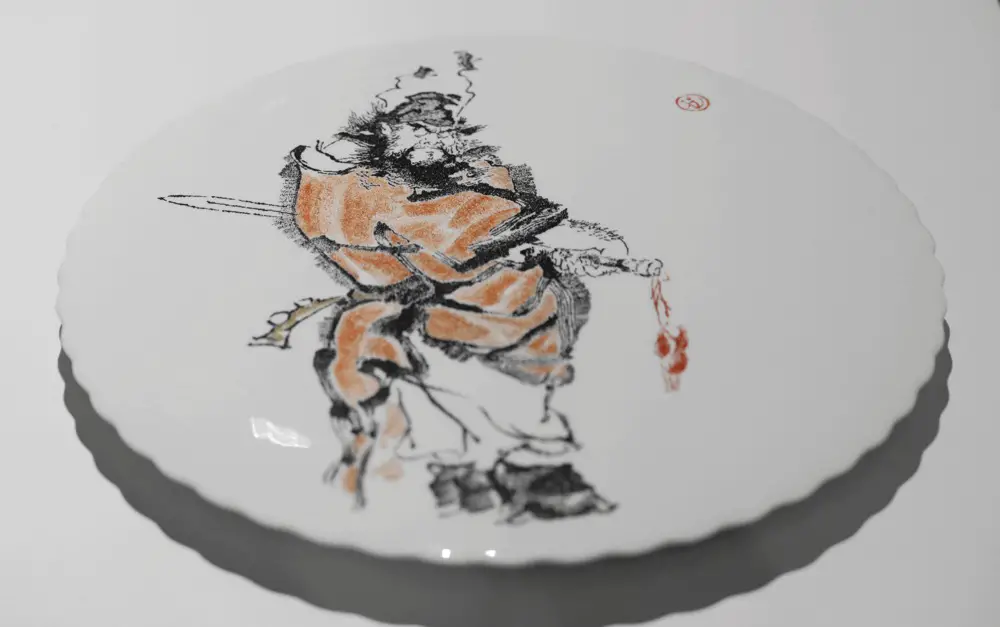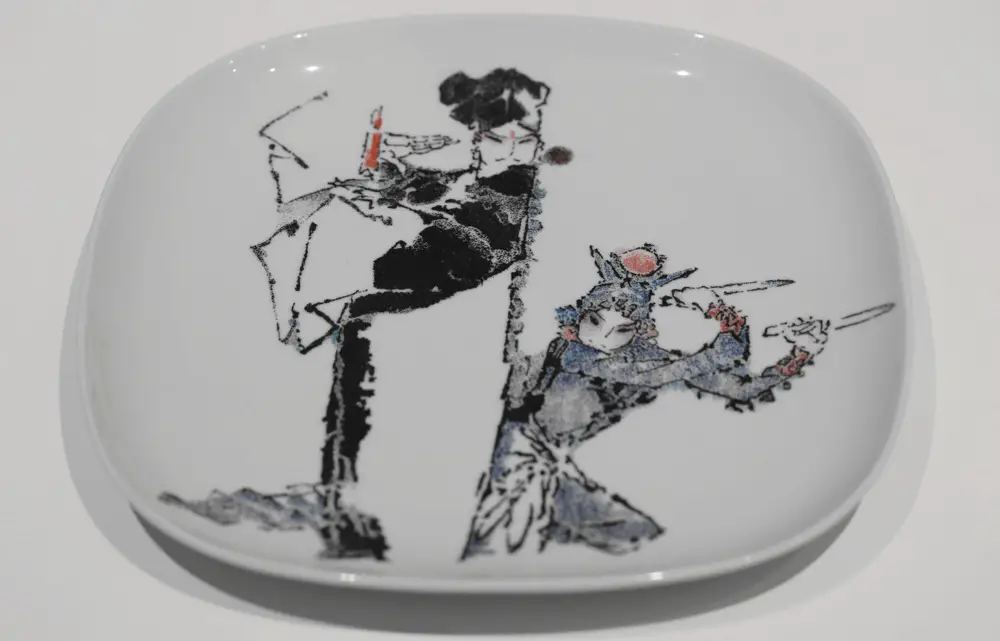Chinese Porcelain Carving,as know an Ceramic engraving, as a unique form of art, blends traditional craftsmanship with modern aesthetics, representing the perfect integration of traditional Chinese ceramic culture and carving techniques. Through the use of carving tools on the surface of ceramics, various patterns, texts, and images are created, imbuing ceramics with profound cultural connotations and artistic value.
Historical Origins of Ceramic Engraving
The history of ceramic engraving dates back to ancient times when symbols and patterns were carved on ceramic vessels for recording and decorative purposes. Over time, the art of ceramic engraving matured into a distinctive form of artistic expression. During the Ming and Qing dynasties, ceramic engraving reached its peak, showcasing exquisite techniques with intricate and elaborate designs.
Craftsmanship Features of Ceramic Engraving
Material Selection: The choice of ceramics as the medium is crucial for ceramic engraving. Typically, ceramics with fine texture and hardness are chosen to facilitate the creation of detailed patterns. Additionally, the color and glossiness of the ceramics affect the overall visual impact of the engraving.

Carving Tools: Artists use various types and specifications of carving tools to meet different engraving requirements. These tools must be kept sharp to ensure smooth lines and clear patterns during the engraving process.
Carving Techniques: Ceramic engraving emphasizes the use of proper carving techniques. Artists must master elements such as pressure, speed, and angles to achieve variations in line thickness, depth, and curvature. Various carving techniques, including positive carving, negative carving, and line carving, are employed to create a rich sense of depth.
Artistic Expression: Ceramic engraving exhibits strong artistic expression, allowing the depiction of various themes such as landscapes, flora and fauna, and figures. Artists skillfully combine patterns on the ceramic surface with the inherent shape and color of the ceramics, creating a harmonious and unified artistic effect.
Chiseling Techniques
In the specific creation process, artisans analyze the material of the ceramic to select suitable chiseling tools. To avoid mistakes during chiseling, craftsmen use transfer paper to imprint the required characters or patterns onto the ceramic. The actual chiseling involves the use of diamond knives or steel chisels. Craftsmen must pay attention to the direction of the blade and control the force to ensure smooth and continuous lines, achieving a fluent chiseling effect.
Blade Techniques
The application of blade techniques in traditional ceramic engraving is crucial and sophisticated. Circular chiseling is a relatively simple blade technique that involves left-pointing, right-pointing, sequential pointing, and reverse-pointing. Jumping-pointing is the most challenging, requiring high proficiency. Beginners are advised to master traditional techniques before attempting jumping-pointing. Flat chiseling involves various techniques such as angle chiseling, twisting chiseling, and flat chiseling. Among them, angle chiseling and twisting chiseling are commonly used due to their strong expressive effects. Mastery of these techniques requires experienced craftsmen to apply them skillfully and bring out their full effect.
Coloring Characteristics
Ceramic engraving utilizes two main coloring methods: glaze dyeing and color dyeing. Glaze dyeing involves using low-temperature glaze colors, akin to the effect of overglaze painting. However, this may risk losing the genuine charm of ceramic engraving. On the other hand, color dyeing employs oil paint pigments. Craftsmen must pay attention to the dilution of pigments, avoiding excessive dilution that may lead to insufficient color density or over-dilution that hinders wiping. The use of traditional Chinese painting pigments is also common, providing transparency and clarity that align with the desired effects of traditional ceramic engraving.
Ceramic Engraving Patterns
Ceramic engraving in DaFeng incorporates rich traditional cultural connotations. The following are common themes found in the patterns:
Landscape Themes: Refined representations of Chinese landscapes, such as the Twelve Peaks, Lion Rock, and Yellow Mountain, are prevalent in DaFeng ceramic engraving.
Figurative Themes: Inspired by literary classics or folk legends, figurative themes depict scenes like the Peach Garden Oath, Su Wu Tending Sheep, Seven Sages of the Bamboo Grove, Moonlit Pursuit of Han Xin, and the spear duel between Xiao Liang Wang. Additionally, there is a trend towards depicting scenes of labor, harvest, and other agricultural activities, combining folk enjoyment with humanistic sentiments, aligning with the modern aesthetic of “people-oriented” concepts.
Flora and Fauna Themes: Animal patterns typically feature auspicious mythical creatures such as dragons, phoenixes, kirins, and cranes. Plant patterns often include evergreen pine and cypress trees, plum blossoms, orchids, bamboo, and chrysanthemums, conveying historical and cultural significance, such as the resilience of pine and cypress, the symbolism of the Four Gentlemen in flowers, and the friendship of the Three Friends in Winter.
Text Patterns: Textual patterns express auspicious meanings, embodying the inheritance of cultural traditions. The patterns not only contain historical and cultural elements but also reflect modern aesthetic habits.
Artistic Value of Ceramic Engraving

Cultural Inheritance: As a crucial component of traditional Chinese ceramic culture, ceramic engraving carries a wealth of historical and cultural significance. Through artistic expression, it conveys ancient ceramic culture, carving techniques, and aesthetic concepts, serving as a valuable historical witness and cultural treasure.
Artistic Innovation: While preserving tradition, ceramic engraving artists continually explore innovative approaches. Modern ceramic engraving artists boldly experiment with materials, carving techniques, and artistic expression, integrating modern aesthetic concepts and technological means into their creations, fostering the contemporary development of ceramic engraving.
Collectible Value: Due to the high level of skill and difficulty involved in its creation, ceramic engraving possesses significant collectible value. Exquisite ceramic engravings are highly sought after in the art market, attracting collectors’ attention.
Tools Used in Production
One of the primary tools used in ceramic engraving is a small iron hammer. The hammer body is 4-5 centimeters long, with a diameter of 1.5-2 centimeters. The handle is typically made of flexible and resilient rattan. Another essential tool is the steel chisel, featuring a hard alloy blade with various types, including coarse, fine, and flat. Additionally, craftsmen may use chisels with pen, round, or triangular shapes based on specific needs.
Heritage and Development of Ceramic Engraving
As society evolves, and aesthetic preferences change, ceramic engraving faces challenges in terms of heritage and development. To protect and pass on this unique art form, the following measures are recommended:
Strengthen Educational Promotion: Organize exhibitions, lectures, and training courses on ceramic engraving to increase public awareness and interest. Cultivate more enthusiasts and inheritors of ceramic engraving.
Encourage Artistic Innovation: Support ceramic engraving artists in exploring innovative approaches while preserving tradition. By incorporating modern aesthetic concepts and techniques, artists can create ceramic engravings that reflect the spirit of the times.
Expand Application Fields: Actively explore the application of ceramic engraving in modern life, such as in home decor and art appreciation. This integration can enhance the relevance of ceramic engraving in contemporary life, providing people with aesthetic enjoyment.
In conclusion, ceramic engraving is a unique art form with rich historical and cultural connotations, as well as high artistic value. It is essential to cherish and promote this traditional art form, striving to ensure its inheritance and development, allowing ceramic engraving to shine even more brightly in the new era.